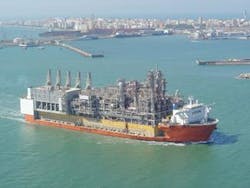Snøhvit LNG barge on course for Barents Sea
Space restrictions demand novel construction approach
Statoil’s Snøhvit field development in the Barents Sea will feature Europe’s first LNG process/export terminal. Dragados Offshore assembled this facility on a steel barge measuring 154 m long, 54 m wide and 9 m deep, and is currently undergoing installation at Melkøya Island off northern Norway.
The sole purpose of the barge, following transportation to the island, is to serve as the foundation for the LNG process plant. At the end of June, the barge and topsides left the Dragados Offshore fabrication yard in Puerto Real, southwest Spain for their 5,000-km voyage to the island.
Due to the extreme weather conditions in northern Norway, Statoil’s rationale was to outsource as much of the construction as possible well away from the island. From Dragados Offshore’s’ point of view, the main challenge has been the constraints imposed by the steel barge’s dimensions. This limited space and access for personnel involved in topsides assembly and of pipework, insulation, electrical, and instrumentation systems. Also, the structural steel was not designed to support a conventional modular construction program. In this regard, the operation proved to be much more complex than a standard offshore module assembly performed on open land at the yard.
The 10,000-ton barge, Izar in Ferrol built , arrived at the yard early last September. To meet the scheduled delivery date of late June 2005, Dragados Offshore implemented a three-pronged strategy:
•Expedite and facilitate access to the barge, once it was in position alongside the quay
• Plan in detail the working sequence
•Take as much assembly work as possible away from the barge.
To simplify access to the barge for the construction team, materials, and lifting gear, the first step was to ground the barge and level its deck to the same height as the quay. To this end, the team placed gravel on the seabed beneath the barge, then ballested the barge.
This solution, however, only addressed access from the quayside. To ensure unfettered access from all sides, the construction team inserted a temporary work platform between one end of the barge and the quay, and brought in an auxiliary barge along the side of Snøhvit’s process barge that was open to the sea. The team grounded the auxiliary barge on a gravel bed to match the height of the process barge’s deck.
Much of the Snøhvit plant could not be put together in modules, but Dragados Offshore undertook detail design of the construction process. This led to the LNG terminal being subdivided into smaller, pancake-type structural sections that could be assembled easily on the barge - i.e., a stick-build approach - following pre-fabrication in the company’s workshops. Dragados still had to plan the fabrication sequences to ensure installation at the right time, according to the area and location.
Despite the apparent rigidity of this approach, the company achieved the necessary flexibility by apportioning sections of the plant to different parts of the yard. The basic idea was to shift resources around where possible to avoid potential bottlenecks during fabrication and erection.
The third main aim was to withdraw as much assembly work as possible from the barge. With a peak labor force of 2,300 working on the barge’s confined space simultaneously, there was as risk of productivity losses due to interference among the various engineering tasks. This, in turn, could have presented a major safety risk.
Having the pancake structures assembled, painted, and fire-proofed in the workshops eased the congestion, as did completion of pipework painting and cleaning prior to erection on the barge. Additionally, the construction team mounted the maximum amount possible of equipment, piping, and cable trays on the structural sections on land at the quayside, close to the erection area. They also outfitted main equipment items such as distillation columns in a horizontal position in the same area with all internals, piping, insulation, and electrical trace heating systems, prior to installation on the barge.
To secure transfer from the quayside of the process plant’s primary and heavier elements, Dragados employed what it says is the world’s second largest land-based crane, with a lifting capacity for this project of 1,400 tons.
Once the team completed assembly work in mid-June, various other tasks were necessary to prepare the plant for its voyage north. First, they had to de-ballast the barge for de-grounding from the gravel base, then tow it to a harbor 500 m away for inspection of the underwater hull. This maneuver was completed on June 21. The plant/barge was then towed to a location 2-km from the yard in the Bay of Cadiz, where Dockwise’s transportation vesselBlue Marlin was already submerged, ready to take onboard the Snøhvit plant following a float-on operation. The surrounding area was dredged to create a water depth of 20 m for this task (the natural depth was around 17 m). On June 27, the transportation vessel returned to the harbor for seafastening of the LNG plant ahead of its voyage northwards, which started three days later.
Transportation of the barge on another vessel avoids stresses on the plant’s steel structure, which might occur following long-distance towing by tugs. Using a dedicated transportation vessel also shortens the duration of the voyage and simplifies maneuvering, decreasing the risk element. The route takes the LNG plant around western France and through the English Channel. The journey had to be undertaken in the summer months as tidal movements in the Barents Sea are more favorable at this time of year for final docking-in operations.
On arrival, the float-off operation should be a reverse of the initial loading procedure. First the seafastening will be cut, followed by ballasting down of the vessel until the Snøhvit barge/plant floats freely in the water. Tugs and winches will then take it to its final location in a dock specially excavated in the island. Once in position, a thick layer of concrete will cover the barge deck.•

